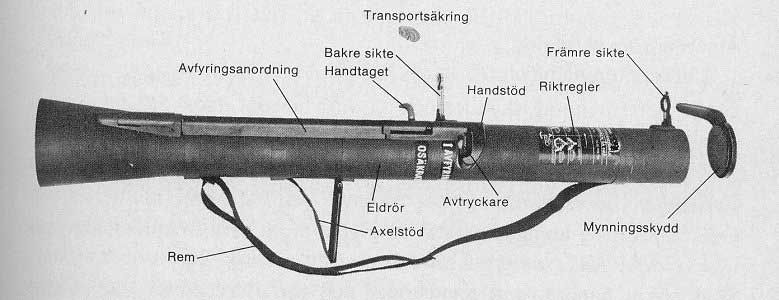The high–low system (or high–low pressure system, high–low propulsion system, high–low projection system) is a design of cannon and anti-tank warfare launcher using a smaller high-pressure chamber to store propellant. It allows a much larger projectile to be launched without the heavy equipment usually needed for large caliber weapons. When the propellant is ignited, the higher pressure gases are bled out through vents (or ports) at reduced pressure to a much larger low pressure chamber to push a projectile forward. The high-low system allows the weight of the weapon and its ammunition to be reduced significantly. Production cost and time are drastically lower than for standard cannon or other small-arm weapon systems firing a projectile of the same size and weight. It has a far more effic
| Attributes | Values |
|---|
| rdfs:label
| - High–low system (en)
- 高低圧理論 (ja)
|
| rdfs:comment
| - 高低圧理論(こうていあつりろん)とは、第二次世界大戦中にドイツで開発された火砲の発射方式に関する理論である。この理論に基づいて戦後にグレネードランチャーが開発され世界中で使用されている。高低圧理論という名称は弾薬の薬莢内に高圧室と呼ばれる装薬の詰った燃焼室と、燃焼ガスを導いて弾薬に伝える低圧室(減圧室)を持つところから由来している。 通常の火砲や銃に比べて腔圧曲線が平坦であるため最大腔圧が低く、銃身や弾丸の肉厚を薄く、強度を低く抑えることが出来、反動も小さい。第二次大戦中、ドイツ軍は対戦車砲として8 cm PAW 600及びを開発。当時の主力対戦車砲である7.5 cm PaK 40の重量が1,500kgであったのに対し、8cm(実際は口径81.4mm)型は640kg、10cm(実際は口径105mm)型で1,035kgと、反動が小さい分軽量に作ることができた。しかし砲弾の初速は前者で520m/s、後者で5 - 600m/sと同時期の対戦車砲に比べ遅いため、HEAT弾の使用が前提となっていた。また名称も「砲」ではなく「投射器」となっている。 大戦後は歩兵用のグレネードランチャー(擲弾発射器)の他コッカリル 90mm低圧砲のような軽量低反動火砲にも利用されているが、東側系のGP-25擲弾発射器や2A28低圧砲などはメカニズムが異なり自己推進弾を利用するものが多い。 (ja)
- The high–low system (or high–low pressure system, high–low propulsion system, high–low projection system) is a design of cannon and anti-tank warfare launcher using a smaller high-pressure chamber to store propellant. It allows a much larger projectile to be launched without the heavy equipment usually needed for large caliber weapons. When the propellant is ignited, the higher pressure gases are bled out through vents (or ports) at reduced pressure to a much larger low pressure chamber to push a projectile forward. The high-low system allows the weight of the weapon and its ammunition to be reduced significantly. Production cost and time are drastically lower than for standard cannon or other small-arm weapon systems firing a projectile of the same size and weight. It has a far more effic (en)
|
| foaf:depiction
| |
| dcterms:subject
| |
| Wikipage page ID
| |
| Wikipage revision ID
| |
| Link from a Wikipage to another Wikipage
| |
| Link from a Wikipage to an external page
| |
| sameAs
| |
| dbp:wikiPageUsesTemplate
| |
| thumbnail
| |
| align
| |
| image
| |
| topic
| - Pansarskott m/68 "Miniman" (en)
|
| has abstract
| - The high–low system (or high–low pressure system, high–low propulsion system, high–low projection system) is a design of cannon and anti-tank warfare launcher using a smaller high-pressure chamber to store propellant. It allows a much larger projectile to be launched without the heavy equipment usually needed for large caliber weapons. When the propellant is ignited, the higher pressure gases are bled out through vents (or ports) at reduced pressure to a much larger low pressure chamber to push a projectile forward. The high-low system allows the weight of the weapon and its ammunition to be reduced significantly. Production cost and time are drastically lower than for standard cannon or other small-arm weapon systems firing a projectile of the same size and weight. It has a far more efficient use of the propellant, unlike earlier recoilless weapons, where most of the propellant is expended to the rear of the weapon to counter the recoil of the projectile being fired. (en)
- 高低圧理論(こうていあつりろん)とは、第二次世界大戦中にドイツで開発された火砲の発射方式に関する理論である。この理論に基づいて戦後にグレネードランチャーが開発され世界中で使用されている。高低圧理論という名称は弾薬の薬莢内に高圧室と呼ばれる装薬の詰った燃焼室と、燃焼ガスを導いて弾薬に伝える低圧室(減圧室)を持つところから由来している。 通常の火砲や銃に比べて腔圧曲線が平坦であるため最大腔圧が低く、銃身や弾丸の肉厚を薄く、強度を低く抑えることが出来、反動も小さい。第二次大戦中、ドイツ軍は対戦車砲として8 cm PAW 600及びを開発。当時の主力対戦車砲である7.5 cm PaK 40の重量が1,500kgであったのに対し、8cm(実際は口径81.4mm)型は640kg、10cm(実際は口径105mm)型で1,035kgと、反動が小さい分軽量に作ることができた。しかし砲弾の初速は前者で520m/s、後者で5 - 600m/sと同時期の対戦車砲に比べ遅いため、HEAT弾の使用が前提となっていた。また名称も「砲」ではなく「投射器」となっている。 大戦後は歩兵用のグレネードランチャー(擲弾発射器)の他コッカリル 90mm低圧砲のような軽量低反動火砲にも利用されているが、東側系のGP-25擲弾発射器や2A28低圧砲などはメカニズムが異なり自己推進弾を利用するものが多い。 (ja)
|
| gold:hypernym
| |
| prov:wasDerivedFrom
| |
| page length (characters) of wiki page
| |
| foaf:isPrimaryTopicOf
| |
| is Link from a Wikipage to another Wikipage
of | |
| is Wikipage redirect
of | |
| is foaf:primaryTopic
of | |



![[RDF Data]](/fct/images/sw-rdf-blue.png)







![[cxml]](/fct/images/cxml_doc.png)
![[csv]](/fct/images/csv_doc.png)
![[text]](/fct/images/ntriples_doc.png)
![[turtle]](/fct/images/n3turtle_doc.png)
![[ld+json]](/fct/images/jsonld_doc.png)
![[rdf+json]](/fct/images/json_doc.png)
![[rdf+xml]](/fct/images/xml_doc.png)
![[atom+xml]](/fct/images/atom_doc.png)
![[html]](/fct/images/html_doc.png)